
  

























 |
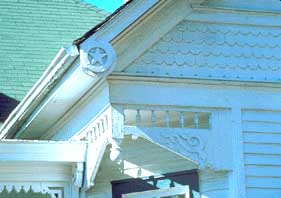
Decorative exterior wood trim and siding. |
Because
it can be easily shaped by sawing, planing, carving, and gouging,
wood is used for architectural features such as clapboard, cornices,
brackets, entablatures, shutters, columns and balustrades.
These
wooden features, both functional and decorative, may be important
in defining the historic character of the building and thus their
retention, protection, and repair are important in rehabilitation
projects. Wood has played a central role in American building during
every period and in every style. Whether as structural membering,
exterior cladding, roofing, interior finishes, or decorative features,
wood is frequently an essential component of historic and older
buildings.
|
|
Wood
|
....Identify,
retain, and preserve
|
 |
|
recommended.....
|

|
| |
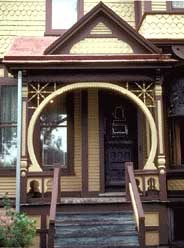
Wood
features on porch repaired and preserved during rehabilitation. |
Identifying,
retaining, and preserving wood features that are important in defining
the overall historic character of the building such as siding, cornices,
brackets, window architraves, and doorway pediments; and their paints,
finishes, and colors.
|
|
not
recommended.....
|

|
| |
Removing
or radically changing wood features which are important in defining
the overall historic character of the building so that, as a result,
the character is diminished.
Removing
a major portion of the historic wood from a facade instead of repairing
or replacing only the deteriorated wood, then reconstructing the
facade with new material in order to achieve a uniform or "improved"
appearance.
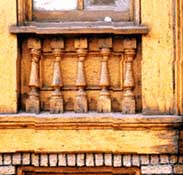
Wood features inappropriately stripped of traditional painted finish. |
Radically
changing the type of finish or its color or accent scheme so that
the historic character of the exterior is diminished.
Stripping
historically painted surfaces to bare wood, then applying clear
finishes or stains in order to create a "natural look."
Stripping
paint or varnish to bare wood rather than repairing or reapplying
a special finish, i.e., a grain finish to an exterior wood feature
such as a front door.
|
|
Wood
|
....Protect
and Maintain
|
 |
|
recommended.....
|

|
| |
Protecting
and maintaining wood features by providing proper drainage so that
water is not allowed to stand on flat, horizontal surfaces or accumulate
in decorative features.
Applying
chemical preservatives to wood features such as beam ends or outriggers
that are exposed to decay hazards and are traditionally unpainted.
Retaining
coatings such as paint that help protect the wood from moisture
and ultraviolet light. Paint removal should be considered only where
there is paint surface deterioration and as part of an overall maintenance
program which involves repainting or applying other appropriate
protective coatings.
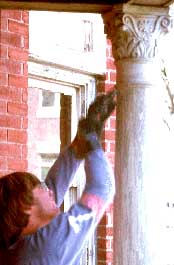
Hand scraping wood column prior to repainting. |
Inspecting
painted wood surfaces to determine whether repainting is necessary
or if cleaning is all that is required.
Removing
damaged or deteriorated paint to the next sound layer using the
gentlest method possible (handscraping and handsanding), then repainting.
Using
with care electric hot-air guns on decorative wood features and
electric heat plates on flat wood surfaces when paint is so deteriorated
that total removal is necessary prior to repainting.
Using
chemical strippers primarily to supplement other methods such as
handscraping, handsanding and the above-recommended thermal devices.
Detachable wooden elements such as shutters, doors, and columns
may--with the proper safeguards--be chemically dip-stripped.
Applying
compatible paint coating systems following proper surface preparation.
Repainting
with colors that are appropriate to the historic building and district.
Evaluating
the overall condition of the wood to determine whether more than
protection and maintenance are required, that is, if repairs to
wood features will be necessary.
|
|
not
recommended.....
|

|
| |
Failing
to identify, evaluate, and treat the causes of wood deterioration,
including faulty flashing,
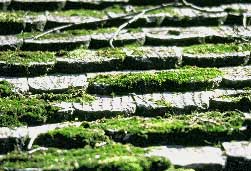
Moss on wood shingles indicative of damaging moisture retention. |
leaking gutters, cracks and holes in
siding, deteriorated caulking in joints and seams, plant material
growing too close to wood surfaces, or insect or fungus infestation.
Using
chemical preservatives such as creosote which can change the appearance
of wood features unless they were used historically.
Stripping
paint or other coatings to reveal bare wood, thus exposing historically
coated surfaces to the effects of accelerated weathering.
Removing
paint that is firmly adhering to, and thus, protecting wood surfaces.
Using
destructive paint removal methods such as a propane or butane torches,
sandblasting or waterblasting. These methods can irreversibly damage
historic woodwork.
Using
thermal devices improperly so that the historic woodwork is scorched.
Failing
to neutralize the wood thoroughly after using chemicals so that
new paint does not adhere.
Allowing
detachable wood features to soak too long in a caustic solution
so that the wood grain is raised and the surface roughened.
Failing
to follow manufacturers' product and application instructions when
repainting exterior woodwork.
Using
new colors that are inappropriate to the historic building or district.
Failing
to undertake adequate measures to assure the protection of wood
features.
|
|
Wood
|
....Repair
|
 |
|
recommended.....
|

|
| |
Repairing
wood features by patching, piecing-in, consolidating, or otherwise
reinforcing the wood using recognized preservation methods.
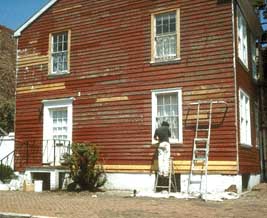
Limited replacement-in-kind of deteriorated wood clapboards. |
Repair
may also include the limited replacement in kind--or with compatible
substitute material--of those extensively deteriorated or missing
parts of features where there are surviving prototypes such as brackets,
molding, or sections of siding.
|
|
not
recommended.....
|

|
| |
Replacing
an entire wood feature such as a cornice or wall when repair of
the wood and
limited replacement of deteriorated or missing parts
are appropriate.
Using
substitute material for the replacement part that does not convey
the visual appearance of the surviving parts of the wood feature
or that is physically or chemically incompatible.
|
|
Wood
|
....Replace
|
 |
|
recommended.....
|

|
| |

Replacing rotted wood column base with new wood. |
Replacing
in kind an entire wood feature that is too deteriorated to repair--if
the overall form and detailing are still evident--using the physical
evidence as a model to reproduce the feature. Examples of wood features
include a cornice, entablature or balustrade.
If using the same
kind of material is not technically or economically feasible, then
a compatible substitute material may be considered.
|
|
not
recommended.....
|

|
| |
Removing
a feature that is unrepairable and not replacing it; or replacing
it with a new feature that does not convey the same visual appearance.
|
| |
Design
for Missing Historic Features
The
following work is highlighted to indicate that it represents the
particularly complex technical or design aspects of rehabilitation
projects and should only be considered after the preservation concerns
listed above have been addressed.
|
|
recommended.....
|

|
| |
Designing
and installing a new wood feature such as a cornice or doorway when
the historic feature is completely missing. It may be an accurate
restoration using historical, pictorial, and physical documentation;
or be a new design that is compatible with the size, scale, material,
and color of the historic building.
|
|
not
recommended.....
|

|
| |
Creating
a false historical appearance because the replaced wood feature
is based on insufficient historical, pictorial, and physical documentation.
Introducing
a new wood feature that is incompatible in size, scale, material
and color.
|
|

